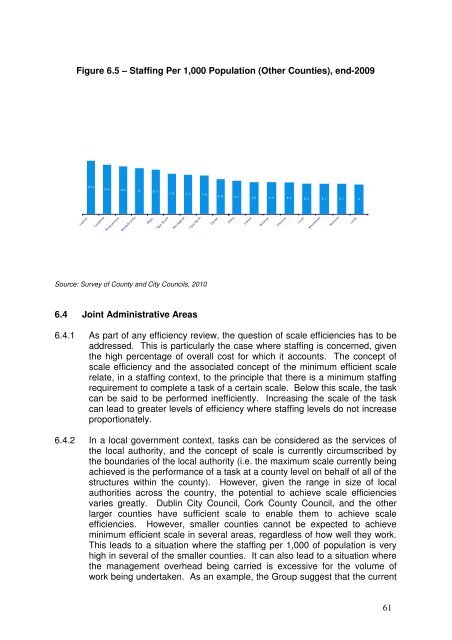Report of the Local Government Efficiency Review Group
Report of the Local Government Efficiency Review Group
Report of the Local Government Efficiency Review Group
Create successful ePaper yourself
Turn your PDF publications into a flip-book with our unique Google optimized e-Paper software.
Figure 6.5 – Staffing Per 1,000 Population (O<strong>the</strong>r Counties), end-2009<br />
Le itrim<br />
10 .4<br />
Longford<br />
9. 6 9.3 9 8 .7<br />
Ro sc ommon<br />
W aterford Co<br />
S lig o<br />
Tipp Sout h<br />
7 .8 7. 7 7. 6<br />
Monagh an<br />
Tip p North<br />
Source: Survey <strong>of</strong> County and City Councils, 2010<br />
6.4 Joint Administrative Areas<br />
Cavan<br />
6 .9<br />
Offa ly<br />
6.7 6.5 6.5 6.4 6.2 6.1 6.1 6<br />
6.4.1 As part <strong>of</strong> any efficiency review, <strong>the</strong> question <strong>of</strong> scale efficiencies has to be<br />
addressed. This is particularly <strong>the</strong> case where staffing is concerned, given<br />
<strong>the</strong> high percentage <strong>of</strong> overall cost for which it accounts. The concept <strong>of</strong><br />
scale efficiency and <strong>the</strong> associated concept <strong>of</strong> <strong>the</strong> minimum efficient scale<br />
relate, in a staffing context, to <strong>the</strong> principle that <strong>the</strong>re is a minimum staffing<br />
requirement to complete a task <strong>of</strong> a certain scale. Below this scale, <strong>the</strong> task<br />
can be said to be performed inefficiently. Increasing <strong>the</strong> scale <strong>of</strong> <strong>the</strong> task<br />
can lead to greater levels <strong>of</strong> efficiency where staffing levels do not increase<br />
proportionately.<br />
6.4.2 In a local government context, tasks can be considered as <strong>the</strong> services <strong>of</strong><br />
<strong>the</strong> local authority, and <strong>the</strong> concept <strong>of</strong> scale is currently circumscribed by<br />
<strong>the</strong> boundaries <strong>of</strong> <strong>the</strong> local authority (i.e. <strong>the</strong> maximum scale currently being<br />
achieved is <strong>the</strong> performance <strong>of</strong> a task at a county level on behalf <strong>of</strong> all <strong>of</strong> <strong>the</strong><br />
structures within <strong>the</strong> county). However, given <strong>the</strong> range in size <strong>of</strong> local<br />
authorities across <strong>the</strong> country, <strong>the</strong> potential to achieve scale efficiencies<br />
varies greatly. Dublin City Council, Cork County Council, and <strong>the</strong> o<strong>the</strong>r<br />
larger counties have sufficient scale to enable <strong>the</strong>m to achieve scale<br />
efficiencies. However, smaller counties cannot be expected to achieve<br />
minimum efficient scale in several areas, regardless <strong>of</strong> how well <strong>the</strong>y work.<br />
This leads to a situation where <strong>the</strong> staffing per 1,000 <strong>of</strong> population is very<br />
high in several <strong>of</strong> <strong>the</strong> smaller counties. It can also lead to a situation where<br />
<strong>the</strong> management overhead being carried is excessive for <strong>the</strong> volume <strong>of</strong><br />
work being undertaken. As an example, <strong>the</strong> <strong>Group</strong> suggest that <strong>the</strong> current<br />
Carlow<br />
Wi cklow<br />
Kilkenny<br />
Lo uth<br />
W estme ath<br />
W exford<br />
La ois<br />
61
















